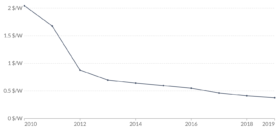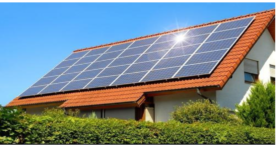Sustainable transitions
Game Changer Solar Module Technology: High Efficiency Solar Panels Catches Attention.
Are you aware of the radical changes in the energy policies of top companies such as Microsoft, Heineken, Shell? They are taking giant strategic steps towards full sustainability. These companies plan to achieve their sustainable goals by using more solar energy than conventional energy sources. While it may seem unrealistic to convert the entire energy supply to solar energy, the advantages of it are overwhelming. First of all, solar energy is the cheapest and most sustainable source of energy in the world. In addition, rapidly developing solar module technology enables us to have more energy in the same unit area to be obtained from solar panels which makes investment more attractive. No one doubts that PERC (P-type) is a main solar panel installed on the roofs, and has been achieving reasonable performance until today. However, TOPCON (N-type) and Perovskite modules are top developments which are likely to drive further growth of solar energy in the years to come.
The main evidence of the impact of solar module technology is the increase in solar energy production from 2% to 3.7% between 2018 and 2021 globally. In these years, the efficiency of solar modules has increased significantly for various reasons and investors have started to obtain more energy with more affordable prices.

Figure 1 illustrates the Global average price of solar modules, measured in 2019$/W and declines further until today up to 0.28$/W.
In order to achieve greater efficiency, PERC (passivated emitter and rear contact) layer was added to the back surfaces of the standard (P-type) solar module, resulting in 2-3% higher efficiency. Such a back surface layer allows more sunlight to capture and turn into electricity, making PERC (P-type) modules more efficient than traditional ones. This development has made PERC (P-type) modules dominant panel type from 2020 onwards, while advancing technology keeps developing new technologies and improving efficiency of panels.
According to Roberto Murgioni, Technical Director of Jinkosolar, global leading solar module manufacturer, there are so many developments and huge R&D investments on solar module technologies. However, in terms of efficiency and degradation rates over the lifetime as well as mass production capability, which is the main reason to make it economically attractive, most promising models are TOPCON (N-Type) and Perovskites.

Figure 2: Residential rooftop solar installation with standard (P-type) modules.
TOPCON (N-type) and Perovskites modules have greater features which is not the case of PERC (P-type) modules. Let’s have a brief look at these advantages and compare them with the PERC (P-type). The most prominent feature of TOPCON (N-type) is that products have very low light induced degradation (LID) which happens in the first two-three weeks of exposure to the sun about 0.5% whereas PERC (P-type) panels suffer around 1.2%. In addition, TOPCON (N-type) panels offer higher power generation (approximately 3%) and lower degradation rate compared to PERC (P-type) panels. These features lead TOPCON (N-type) panels to achieve better performance over lifetime.
The advantage of perovskite panels over PERC (P-type) is that they can react to light of a variety of different wavelengths, allowing them to convert more of the sunlight that reaches them into electricity. However, PERC (P-type) solar panels don’t respond to all wavelengths. Moreover, the other advantage of Perovskite is that it uses less material in order to absorb the same amount of light compared to PERC (P-type). Last but not least, the manufacturing cost of Perovskite is cheaper than PERC (P-type) so together with high efficiency potential it will make Perovskite one of the main technologies.
On the other hand, perovskite solar modules still face several challenges. It contains lead, which is a neurotoxin and industry is heavily working on ways to reduce its toxicity. Researchers have tried alternatives, such as tin, but performance decreases. According to Roberto Murgioni, Perovskites panels can boost the efficiency up to 30% and at this stage it is under R&D check. The solar module industry plans to apply this technology after 2030 when the toxic issue will be resolved.
Besides, highly efficient TOPCON (N-type) and Perovskites modules have breakthrough efficiency like 28.2% to ~28.7% and 25.17% respectively. These are greater than PERC modules (24.5%). More specifically, a regular Dutch household on average needs 2kW system and they need 6 PERC (P-type) modules on the roof; whereas they need only 5 TOPCON ( N-type) modules on same size and optimistically this number will decrease further in mid future with Perovskites solar modules. Arjen Jagersma, CEO of Solartoday, said that TOPCON (N-type) is the main module for Dutch market where space is limited so you can get maximum efficiency and greater performance (no LID) on your roof-top projects. Therefore, we can expect to see more TOPCON (N-type) solar on the market. However, it seems that Perovskites solar models have a little more time for investors due to toxic problems despite their high efficiency.
Developing solar module technology has allowed us to get a more realistic perspective on companies’ plans. In fact, Dutch brewer HEINEKEN’s corporate energy plan seems reliable. They are moving towards 100% renewable energy and have already started to use solar energy. Today, already more than 26,000 solar panels have been installed on the roofs of breweries. By January 2022, HEINEKEN beers will be provided with fully sustainably produced electricity. Thanks to the developing solar module technology and its maintenance free operation, it encourages HEINEKEN to invest more on solar. All of these steps have become an important turning point in the journey of the company.
In addition, these developments in solar module technology enables everyone (individuals,governments and corporations) to think seriously about solar energy investment and make plans for the future. Like many other countries, the Dutch government provides significant subsidies and financial incentives to boost solar energy a few years ago which already made the Netherlands third country globally in terms of Watt per capita. They are committed to providing 50% of electricity through renewable energy sources by 2025 according to the Paris Climate Agreement although there is still a lot to do. The government also has a subsidy scheme, called SDE++, for commercial and utility scale free field projects depending on technology and saved CO2.
Emerging solar module technology is extremely thrilling for a sustainable world. New developments in solar modules have made solar energy the cheapest source of energy in the last few years and it has the potential for further development in terms of technology and cost. For these reasons, solar modules have started to change the game. For example, 50% of global energy investments in 2020 were only in solar energy. However, there are still few concerns about solar energy, such as grid capacity and available land. Arjen Jagersma, CEO of Solartoday, said that it would be a big surprise if Dutch government achieves their ambitious goal regarding solar energy by 2025. However, if we look at the progress and think optimistically, they will come into the neighborhood. What do you think? Will they achieve their goal and solar energy really be our main energy source soon? Looking forward!
Written by Natali Kiristopuryan
References:
- https://www.theheinekencompany.com/newsroom/heineken-announces-drop-the-c-programme2/
- https://www.government.nl/topics/renewable-energy/stimulating-the-growth-of-solar-energy
- https://www.myutilitygenius.co.uk/blog/renewable-energy-in-big-brands/
- https://www.ise.fraunhofer.de/content/dam/ise/de/documents/publications/conference-paper/28-eupvsec-2013/Feldmann.pdf
- https://www-sciencedirect-com.proxy.library.uu.nl/topics/engineering/perovskite-solar-cells

